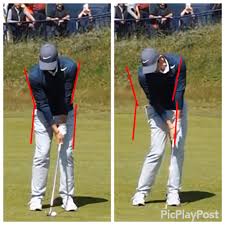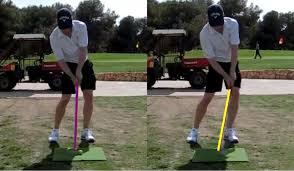
Why Most Golfers Struggle with Shaft Lean
Understanding Shaft Lean and Common Swing Flaws with Amateur Golfers
As a professional golf coach with over 25 years of experience, I have seen countless golfers struggle with achieving proper shaft lean at impact. Hi, my name is coach Erik Schjolberg of EJS Golf.

Shaft lean is a critical aspect of a successful golf swing, yet many golfers fail to achieve it due to various swing flaws. In this blog, I will delve into why most golfers do not have shaft lean, the swing flaws that contribute to this issue, and how to correct them. For those interested in improving their game, I offer personalized golf lessons in Scottsdale, AZ, and online. Go to EJS Golf for more information and to learn more about my golf coaching services.
What is Shaft Lean?
Shaft lean refers to the angle of the club shaft at impact. When the shaft of the club is leaning toward the target at the moment of impact, it is known as forward shaft lean. This position is crucial for compressing the ball, maximizing distance, and achieving the desired ball flight. Conversely, backward shaft lean, where the club leans away from the target, results in weak and inconsistent shots.

Why Most Golfers Lack Shaft Lean
Many golfers struggle with achieving forward shaft lean due to a combination of technical flaws and misunderstandings about the golf swing. Here are some common reasons why golfers fail to achieve proper shaft lean:
1. Improper Wrist Action
One of the primary reasons golfers lack shaft lean is improper wrist action during the swing. The lead wrist should be in a flexed or bowed position at impact, which helps maintain the forward shaft lean. However, many golfers extend their wrists too much at the top of the backswing, making it difficult to achieve the correct position at impact.
2. Early Release or Casting
Casting, or releasing the club too early in the downswing, is a common flaw that prevents forward shaft lean. When golfers cast the club, the clubhead passes the hands too soon, resulting in a loss of lag and backward shaft lean. This issue often stems from a misunderstanding of the proper release pattern and a lack of body rotation through impact
3. Lack of Body Rotation
Proper body rotation is essential for maintaining shaft lean. Golfers who fail to rotate their bodies adequately during the downswing often compensate by flipping their wrists, leading to backward shaft lean. Ensuring that the hips and shoulders rotate through impact can help maintain the correct shaft angle.
4. Poor Setup Position
A golfer's setup position can significantly impact their ability to achieve shaft lean. Starting with too much or too little shaft lean at address can lead to inconsistencies at impact. A slight forward shaft lean at address can help golfers return to this position at impact, promoting a more consistent strike.
5. Overemphasis on Shaft Lean
While forward shaft lean is essential, overemphasizing it can lead to other swing issues. Golfers who focus too much on leaning the shaft forward may inadvertently open the clubface or fail to rotate their bodies correctly, resulting in poor ball striking and potential injury
Common Swing Flaws and How to Correct Them
Now that we understand why golfers struggle with shaft lean, let's explore some common swing flaws and how to correct them.
1. Flawed Wrist Action
Problem: Excessive wrist extension at the top of the backswing.
Solution: Focus on maintaining a flexed lead wrist throughout the swing. Drills that emphasize wrist flexion, such as slow-motion swings or using training aids like the HackMotion device, can help golfers develop the correct wrist position.
2. Early Release or Casting
Problem: Releasing the club too early in the downswing.
Solution: Work on maintaining lag by practicing drills that promote a delayed release. One effective drill is the "pump drill," where golfers pause halfway down the downswing to check their wrist position before completing the swing.
3. Lack of Body Rotation
Problem: Insufficient body rotation through impact.
Solution: Emphasize proper hip and shoulder rotation during the downswing. Drills that encourage body rotation, such as the "step-through drill," can help golfers develop a more connected swing and maintain shaft lean
4. Poor Setup Position
Problem: Incorrect shaft lean at address.
Solution: Ensure a slight forward shaft lean at address by positioning the hands slightly ahead of the ball. Regularly check your setup position using mirrors or video analysis to maintain consistency.
5. Overemphasis on Shaft Lean
Problem: Overemphasizing forward shaft lean, leading to other swing issues.
Solution: Focus on a balanced approach to the swing, incorporating proper wrist action, body rotation, and setup position. Avoid fixating solely on shaft lean and consider the overall mechanics of the swing.
Stories from Coach Erik's Students at EJS Golf
Story 1: Transforming John's Game with Shaft Lean
John came to me as a mid-handicap golfer struggling with consistency and distance. One of the most glaring issues in his swing was the lack of shaft lean at impact. His low point was consistently behind the ball, leading to thin and fat shots. This lack of forward shaft lean was costing him both accuracy and distance.
When John first arrived at my academy, I immediately noticed his wrist action was incorrect. He had a tendency to extend his wrists too early in the downswing, resulting in a casting motion. This early release not only robbed him of power but also prevented him from achieving the desirable forward shaft lean.
We started by addressing his wrist action. I introduced John to the concept of maintaining a flexed lead wrist throughout the swing. Using alignment sticks, I demonstrated how to position his hands slightly ahead of the ball at address. This setup helped him visualize the correct impact position. We practiced slow-motion swings with the alignment sticks to reinforce this new wrist position.
Next, we tackled his body rotation. John had a habit of using his arms too much and not rotating his body adequately. I introduced him to the "step-through drill," which encourages proper hip and shoulder rotation. This drill helped John understand the importance of using his body to create dynamic shaft lean rather than relying solely on his hands and arms.
Over the course of several lessons, John made remarkable progress. His low point moved from being behind the ball to an average of 5 inches ahead with a 7-iron. This shift in his swing mechanics resulted in a significant improvement in his ball striking. He went from having negative shaft lean to achieving 10-14 degrees of forward shaft lean at impact.The results were astounding. John's consistency improved dramatically, and he gained an average of 15 yards with his irons. His shots were more penetrating and had a much better trajectory. The increased shaft lean allowed him to compress the ball better, resulting in more distance and control.
Seeing John's transformation was incredibly rewarding. By focusing on proper wrist action, body rotation, and using alignment sticks for drills, we were able to correct his swing flaws and achieve the desired shaft lean.
This story is a testament to how targeted practice and understanding the mechanics of the golf swing can lead to significant improvements.If you're struggling with similar issues, I encourage you to visit EJSGolf.com for personalized golf lessons. Whether you're in Scottsdale or prefer online lessons, I can help you achieve your golfing goals.
Story 2: Sarah's Journey to Consistent Ball Striking
Sarah, a high school golfer with a promising future, came to me frustrated with her inconsistent ball striking. Despite her talent, she struggled with achieving forward shaft lean at impact, leading to weak and erratic shots. Her low point was often behind the ball, causing her to hit thin and fat shots frequently.
During our first session, I observed that Sarah's setup position was not conducive to achieving forward shaft lean. Her hands were too far behind the ball, and she lacked the necessary wrist flexion. Additionally, her body rotation was insufficient, causing her to flip her wrists at impact.
To address these issues, we began by correcting her setup position. I used alignment sticks to help Sarah position her hands slightly ahead of the ball at address. This adjustment gave her a visual cue for the correct impact position. We practiced this setup repeatedly until it became second nature. Next, we focused on improving her body rotation. I introduced Sarah to the "pump drill," where she paused halfway down the downswing to check her wrist position before completing the swing. This drill helped her maintain lag and delayed the release, promoting forward shaft lean. We also worked on drills that emphasized proper hip and shoulder rotation. Using alignment sticks, I showed Sarah how to keep her body turning through impact. This rotational force helped her maintain the desired shaft lean without relying on her hands and arms.
Over time, Sarah's swing mechanics improved significantly. Her low point moved from being behind the ball to an average of 3 inches ahead with a 7-iron. She went from having negative shaft lean to achieving 6-8 degrees of forward shaft lean at impact. The impact on her game was profound. Sarah's consistency improved, and she gained an average of 12 yards with her irons. Her shots were more powerful and had a better trajectory. The increased shaft lean allowed her to compress the ball effectively, resulting in more distance and control.
Witnessing Sarah's transformation was incredibly satisfying. By focusing on proper setup, wrist action, and body rotation, and using alignment sticks for drills, we were able to correct her swing flaws and achieve the desired shaft lean.
This story highlights the importance of understanding and practicing the mechanics of the golf swing.If you're facing similar challenges, I invite you to check out my Scottsdale Golf Lessons and Online Golf Lessons at EJS Golf. Together, we can work on improving your game and achieving your golfing goals.
Conclusion
Both John and Sarah's stories illustrate the transformative power of achieving proper shaft lean. By addressing common swing flaws such as improper wrist action, early release, and lack of body rotation, and using alignment sticks for drills, we were able to make significant improvements in their games. These changes led to better consistency, increased distance, and more control over their shots.
By understanding and addressing the common swing flaws that prevent proper shaft lean, you can achieve more consistent and powerful ball striking. Remember, improvement starts with the right knowledge and practice. Let's work together to make your golf game better from the very first lesson.
If you're struggling with shaft lean or other swing issues, I encourage you to visit EJSGolf.com for personalized golf lessons. Whether you're in Scottsdale or prefer online lessons, I am here to help you achieve your golfing goals. Let's work together to make your game better from the very first lesson.
